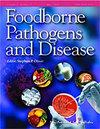Assessment of the Microbiological Quality and Effect of Public Health of Ready-to-Eat Salad Samples in Isparta.
IF 1.9
2区 农林科学
Q3 FOOD SCIENCE & TECHNOLOGY
引用次数: 0
Abstract
Salmonella spp. and Citrobacter spp. are among the microorganisms causing important foodborne outbreaks. In this study, it was tried to determine the presence and rate of Salmonella spp. and Citrobacter spp. in salad samples collected from certain regions of province of Isparta in Türkiye. A total of 50 salad samples were analyzed. Classical culture technique was used for microbiological analysis of salad samples. Suspected isolates obtained were identified using the VITEK-2 system. Although no negative visual changes were observed in the salad samples used in the study, it was determined that the number of Gram-negative microorganisms was very high and six salad samples were not suitable for public health. In 50 salad samples, 2% Salmonella and 4% Citrobacter freundii were detected. In addition, it was determined that the Salmonella strain isolated from the salad sample was resistant to three different antibiotics and Citrobacter was resistant to two different antibiotics. Salmonella spp. and Citrobacter spp. are considered very dangerous to public health because they are associated with foodborne outbreaks and can develop antibiotic resistance very quickly. Salad producers should try to reduce the possibility of microbial contamination by using different technologies.伊斯帕尔塔市即食沙拉样本的微生物质量及其对公众健康影响的评估。
沙门氏菌属和柠檬酸杆菌属是导致重大食源性疾病爆发的微生物之一。本研究试图确定从土耳其伊斯帕尔塔省某些地区采集的沙拉样本中沙门氏菌属和柠檬酸杆菌属的存在情况和比例。共分析了 50 份沙拉样本。沙拉样本的微生物分析采用了经典培养技术。使用 VITEK-2 系统对获得的疑似分离物进行鉴定。虽然在研究中使用的沙拉样本中没有观察到负面的视觉变化,但确定革兰氏阴性微生物的数量非常高,6 个沙拉样本不适合用于公共卫生。在 50 个沙拉样本中,检测到 2%的沙门氏菌和 4%的柠檬酸杆菌。此外,从沙拉样本中分离出的沙门氏菌株对三种不同的抗生素有抗药性,而柠檬酸杆菌则对两种不同的抗生素有抗药性。沙门氏菌属和枸橼酸杆菌属被认为对公共卫生非常危险,因为它们与食源性疾病爆发有关,并能很快产生抗生素耐药性。沙拉生产商应尽量采用不同的技术来减少微生物污染的可能性。
本文章由计算机程序翻译,如有差异,请以英文原文为准。
求助全文
约1分钟内获得全文
求助全文
来源期刊

Foodborne pathogens and disease
医学-食品科技
CiteScore
5.30
自引率
3.60%
发文量
80
审稿时长
1 months
期刊介绍:
Foodborne Pathogens and Disease is one of the most inclusive scientific publications on the many disciplines that contribute to food safety. Spanning an array of issues from "farm-to-fork," the Journal bridges the gap between science and policy to reduce the burden of foodborne illness worldwide.
Foodborne Pathogens and Disease coverage includes:
Agroterrorism
Safety of organically grown and genetically modified foods
Emerging pathogens
Emergence of drug resistance
Methods and technology for rapid and accurate detection
Strategies to destroy or control foodborne pathogens
Novel strategies for the prevention and control of plant and animal diseases that impact food safety
Biosecurity issues and the implications of new regulatory guidelines
Impact of changing lifestyles and consumer demands on food safety.
 求助内容:
求助内容: 应助结果提醒方式:
应助结果提醒方式:


